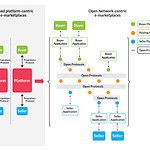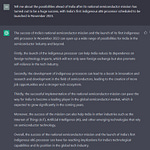Matsyanyaaya: Russia’s response to Crippling Tech Sanctions
— Aditya Pareek
The Russian government’s response to the devastating series of embargoes, sanctions and export controls barring high-tech components and semiconductor chips is interesting. One of the measures intended for immediate relief is the legalisation of parallel or gray imports. Parallel imports will lead to the Russian market being supplied with products without their Original Equipment Manufacturer(OEM) or Intellectual Property(IP) rights holder’s permission. Gray or parallel imports are generally seen as iterations of a product intended for another market being sold in another - which is either illegal in some jurisdictions or a gray area in others. This gray trade is generally undertaken by intermediaries, stockpilers or resellers who have no formal ties to the OEM or IP owner. The prevalence of gray imports can also lead to lower quality or counterfeit products being supplied, but there are few alternatives for Russia in the short term.
In the medium term, Russia is also hoping that Chinese foundries and other production facilities will supply the needed semiconductor chips. However, it is unclear if Chinese companies which own these facilities will risk being slapped with secondary sanctions and losing access to much-needed US IP, to fulfil demand from the Russian market.
As identified in our issue paper on the subject, Russia has a few major players like Mikron Group, Zelnograd Nanotech Center, GS Nanotech. However, these Russian companies only have the equipment to work on trailing edge 250-90nm chips and not cutting edge ones.
In the long term, Russia plans to invest almost 3.19 Trillion Roubles in setting up more domestic manufacturing capacity. A key goal highlighted behind this new investment is to set up production facilities that can churn out 28nm chips by the year 2030. As identified in these Russian media reports, despite the government throwing money at the problem, it will be a tough nut to crack within 7-8 years as the 2030 timeframe implies. Historical precedent shows that even in more cordial times, it has not been easy for Russia to secure semiconductor manufacturing equipment from foreign sources. Cutting out foreign sources entirely and manufacturing complex photolithography equipment needed for this goal would take even more time, possibly 2-3 decades, by which time the plot will be lost.
If you enjoy the contents of this newsletter, please consider signing up for Takshashila’s Graduate Certificate in Public Policy(GCPP) Programmes.
Click here to know more
Antariksh Matters: Nuance is important in the era of dual-use of space
— Aditya Pareek
While the India-US Space situational Awareness(SSA) agreement is a huge development, it is important to understand the nuance in the fact that which agencies from the two countries signed it.
As I highlighted in this tweet thread:




Transparency around SSA is an issue that ISRO hadn’t prioritised before, as Pradeep Mohandas & I opined in this The Wire Science article in December 2020. Glad to see that things are now changing with ISRO coming out with a “Space Situational Assessment 2021”.




False Information around Russia & Starlink
A worrying claim was circulating on social media around 16th April, that Russia’s military was ordered to destroy Starlink satellites. The reason alleged in the fake statement was that Starlink helped target the Russian Navy’s capital ship “Moskva”. The fake statement was attributed to the deputy chairman of the Security Council of Russia and the chairman of the Russian party in power, “United Russia”.
The website which hosted this fake statement had almost identical content (apart from the fakes) to the genuine website of United Russia.

The fake website appears to have since been taken down, but according to Internet Archive’s Wayback Machine it existed since at least 2004.
Provocative fake content is nothing new in the information domain and has become a major part of modern hybrid wars but the potential for escalation around the conflict in space is a sensitive issue. With the earth’s orbit becoming densely populated with satellites and spacecrafts, any attempts by belligerent countries to take out another’s space objects will also endanger the space assets of countries not involved in any hostilities. Debris generated from a kinetic attack against any space object may indiscriminately damage and destroy anything in its path. This can lead to collaterally affected countries either seeking damages from the country responsible for the attack, or, in a more extreme case, retaliating against it.
Matsyanyaaya: How China is Winning the Quantum Computing Race
— Arjun Gargeyas
An edited version of this article came out in CNN-News18 on April 14, 2022.
Recent reports from China have mentioned how researchers and scientists from the country have managed to develop cooling systems using Helium gas as an alternative to the traditional cryogenic cooling systems used in the development of quantum computers.
Quantum computing has clearly become an area of concern for the US with regard to China’s rise in the domain as well as potential military applications of the technology so it is not surprising that techno-nationalist tendencies have been showcased by the American government in this regard. For instance, the Export Control Reform Act (ECRA) was extended to quantum technology products in 2018. This included critical quantum refrigerators and cryogenics along with software and AI for building quantum computers. This was done in order to make cross-border collaboration with Chinese nationals and academic institutions more difficult.
China and its Rapid Rise
While establishing itself as the leader in quantum communications technology, China soon started dedicating its resources to developing alternative quantum computing technologies. As the global leader in patents related to quantum communication and cryptography, China has advanced by leaps and bounds in the quantum computing domain over the last decade. Once behind the West in developing quantum computers, China now houses two of the world’s fastest quantum computers on its soil. The unveiling of ‘Zuchongzhi-2’, the country’s fastest quantum computer, in late 2021 has effectively made the country a powerhouse in quantum computing and on par with the US.
The pace at which China has adopted quantum computing technology is truly exceptional, with the country claiming ‘quantum advantage’ in both the superconducting qubit and photonic tech (two different types of technologies used to develop quantum computers). Immense state support has been provided by the Chinese government to both academic institutions (University of Science and Technology China (USTC), Tsinghua and Peking Universities) and private companies (Origin Quantum, Qasky, and Huawei Cloud) for the development of quantum computers in the country. The recent advances made by China in the domain of quantum computing have resulted in increased global protectionism in the field.
The Catalysts for the Rise
Quantum computing works on the principle of ‘qubits’, also called quantum bits that have the ability to store values anywhere between 0 and 1 resulting in more computational capacity. To operationalise these qubits, there are several different technologies that have been developed. Each has its own advantages and dependencies, based on which the choice is made by the government or private sector to invest.
In China, the role of the state and the government have played an important role in spearheading its scientific and technological progress. The synergy that exists between the state and the domestic private sector has been exemplary in various domains and quantum technology remains no exception. The government has provided funding to academic institutions in setting up labs for quantum computing research and financial support to domestic tech companies engaged in building real-world applications for quantum computers. In a way, the state acts like a bridge and a facilitator, helping translate academic research in the quantum computing space to build actual quantum computers and develop applications for these devices.
Apart from the role of the government and the state, one of the main catalysts for the rise of China in certain critical and strategic technologies is the ability to bypass restrictions that might prevent its growth and development in the field. There have been numerous export controls and import restrictions in the quantum tech domain on cryogenic (very low temperatures) cooling systems. But Chinese researchers ended up developing breakthroughs in an alternative field of quantum computing technology such as photonic computing that does not need intense refrigeration. Recently, there were also reports about Chinese scientists developing cooling systems using Helium gas that would dilute the existing restrictions in place. Shanghai-based researchers were able to create a device that could create the extremely low temperatures that quantum computers typically operate in. This would mean that China, regardless of the technological sanctions and other restrictions on its industry, continues to rise in the quantum computing field leaving others trailing behind.
The Chinese government’s role as a facilitator to academia and the private sector ensured continuous uninterrupted technological development. The ability to negate the restrictions placed by the US and its allies in the quantum computing field also entrenched its position in the domain. It has also led to key technological breakthroughs that would not have seemed possible in case the controls were not in place. Hence, this has created a win-win scenario for the Chinese quantum tech industry, generating both IP and reducing dependencies on the West. India should seek to learn from China’s catalysts for growth to succeed in its own quantum computing initiative.
Our Reading Menu
[Book] China and Great Power Responsibility for Climate Change by Sanna Kopra
[Opinion] As Russia Reels Under Cascading Effects of Chip Starvation, China May Not Be a Dependable Partner by Aditya Pareek and Arjun Gargeyas who are also contributors to this newsletter
[Research Article] Mutually assured surveillance at risk: Anti-satellite weapons and cold war arms control by Aaron Bateman
[Article] The forgotten history of small nuclear reactors by M.V. Ramana










